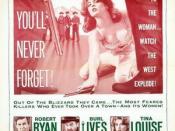E N G3U1-07
October 24, 2013
1
Lit e rary Ana l ysis of " The O utl aw " by Sin c lair R o ss
Neetya Sarin
Through the use of literary elements and techniques such as symbolism, anthropomorphism and figurative language, Sinclair Ross addresses the theme of isolation, both literal and figurative, and the failure of people to notice their surrounding environment due to their pre-occupation with getting the approval of others, in his short story, "The Outlaw".
"The Outlaw" is written from the point of view of a thirteen year old boy who hopes to "wipe out all the ignominy of [his] past" (Ross 47) and impress others at his school. Horses are a recurring symbol for creativity and fulfillment in many of Ross's written works, and in this story specifically, the young boy projects all his thoughts and feelings onto his horse, Isabel, who therefore becomes a symbol for his dreams, aspirations and attitude towards life.
The boy has a strong desire to become an adult and seeks guidance from Isabel on his path towards maturity.
As well, Millie Dickson, the young boy's love interest in "The Outlaw" acts as a symbol for the conventional figure of masculine testing and triumph, as the boy is vying for her affection and attention throughout the course of the story.
Isabel is given anthropomorphic (human) qualities in the sense that she is portrayed as a "temptress" (47) with "nuzzling, velvet lips" (47) and a "gleaming, queenly" (47) beauty about her, who "sized [the boy] up, evidently, as soft-hearted as well as faint-hearted, and decided there was a chance that [he] might weaken and go riding" (46). Through this line, Ross reveals the boy's sense of insecurity and inferiority, and as a result,


